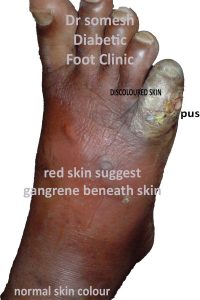Diabetic Gangrene Foot
Gangrene – is tissue death in part of the body , It can affect any part of the body but usually starts in the toes, feet, fingers and hands. It affects commonly toes foot and limbs in diabetes.
Risk factors
Risk factors
Diabetes – In diabetes foot , Your are in high risk if your having sensory loss where people don’t notice any injury allowing infection to spread causing death of tissue or because of decreased blood supply due to blocks in arteries
Blood vessel disease – Hardened and vessel narrowing in arteries (atherosclerosis) and blood clots
block blood flow to any area of your body.
Trauma – trauma to skin and underlying tissue ( injury or frostbite, bare foot walking injuries) increases risk of developing gangrene because sensory loss does not notice injury unless infected and gangrene develops
Smoking- Dry gangrene is commonly associated with smokers .
Obese persons accompanies diabetes and vascular disease due to metabolic syndrome,
Any compression injury to vessels increasing risk of infection and poor wound healing.
Immunosuppression – If you have HIV or if undergoing chemotherapy or radiation therapy, your body’s ability to fight off an infection is impaired.
Diabetic Gangrene Foot types
1) Dry gangrene
2) Wet gangrene
Wet gangrene –
80% of amputations are due to previous non healing ulcers,
Wet gangrene presents
with callus non healing ulcer turning into infection cellulitis and diabetic gangrene foot
bare foot walking injury leading to bacterial entry into body and infection necrosis
Happens in diabetic foot with gangrene because of neuropathy (sensory loss not able to perceive any injury has happened allowing bacteria to enter into body and noticing only after gangrene or pus formation )
Callus ,non healing ulcers, in diabetes due to motor neuropathy are at hisk risk of turning diabetic foot with into gangrene if not healing for more than three months
wet gangrene affects tissues under the surface of your skin, such as gas gangrene or internal gangrene,
Symptoms depend on the location and cause of the gangrene. If the skin is involved, or the gangrene is close to the skin, the symptoms may include:
Diabetic foot with gangrene presents as

- skin discolouration from black if skin affected , red or bronze if affected area is beneath the skin
- foot swollen
- sores or blister formation filled with pus or fluid that bleed or dirty looking

- foul smelling discharge
- warmth in leg of affected foot felt on touching compared to other foot
- severe continous pain in the affected area
- loss of appetite
- fever > 38C or above
- generally feel unwell
- feeling hot and shivery
- rapid heartbeat (tachycardia)
Dry gangrene – is due to blocks in arteries supplying foot ,
- skin will be turned black or pale in colour
- foot not swollen unless infected
- pain due to ischemia decreases on hanging legs down , increases on lying down in bed (because blood flow is decreasing to foot on elevation
- skin is thin , shiny without hair
- feels cold to touch

Dry Gangrene Foot
in some cases, the affected limb will be heavy and produce a crackling sound on pressing the skin. These symptoms are suggestive of gas gangrene caused by a buildup of gas under the skin.
If diabetic gangrene foot not managed early with proper treatment, complications like
septic shock can occur if a infection in the dead tissue spreads throughout your body.
Presents as :
Low BP (blood pressure)
Fever,
heart rate increased
giddiness
difficulty in breathing
Confusion
Gangrene needs immediate treatment. otherwise it can even lead to death due to multi organ failure.
Causes
Infection – death of tissues happens due to bacterial infection if not treated early
Lack of blood supply- blood carries nutrients with oxygen to feed your tissues , and
immune system to prevent infections. If proper blood supply is not there, cells can’t survive, and tissue necrosis occurs.
Severe Trauma – any break in skin due to trauma, when these tissues are infected, gangrene due to necrosis can occur.
Complications
Gangrene might need plastic surgery who want faster healing
If tissue death is extensive, such as in your foot, may need to be amputated.
Gangrene can damage other organs due to sepsis like kidney failure , lungs (ARDS) and even death can happen if not treated early
